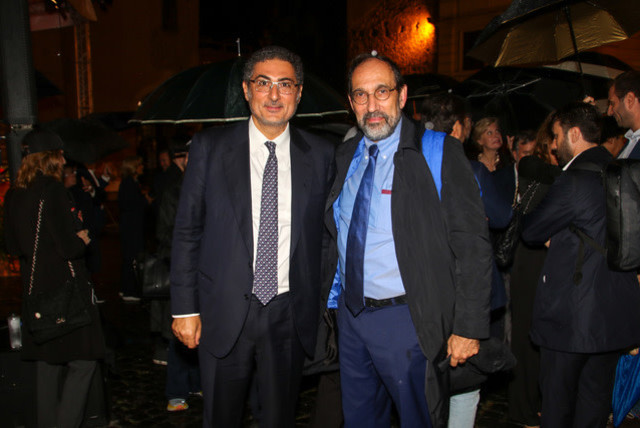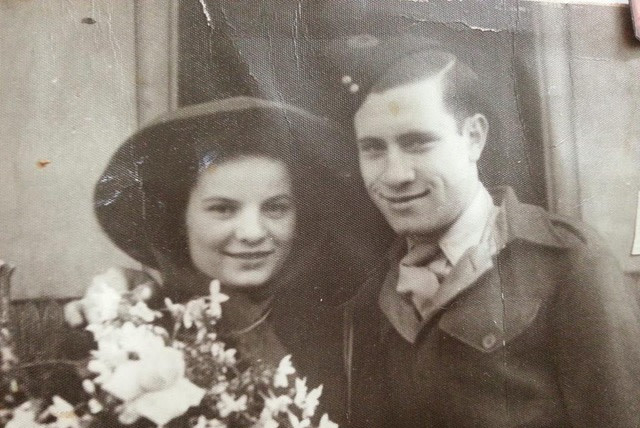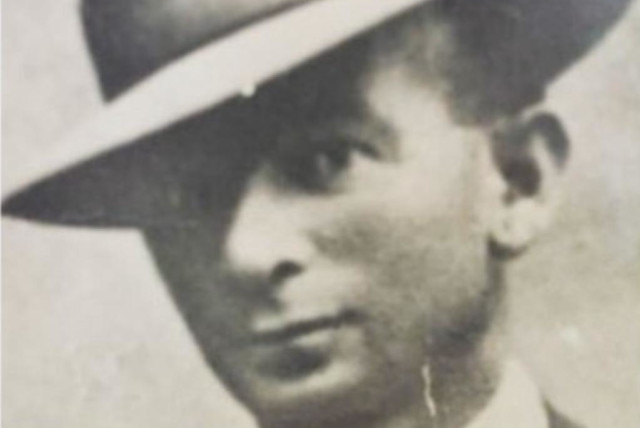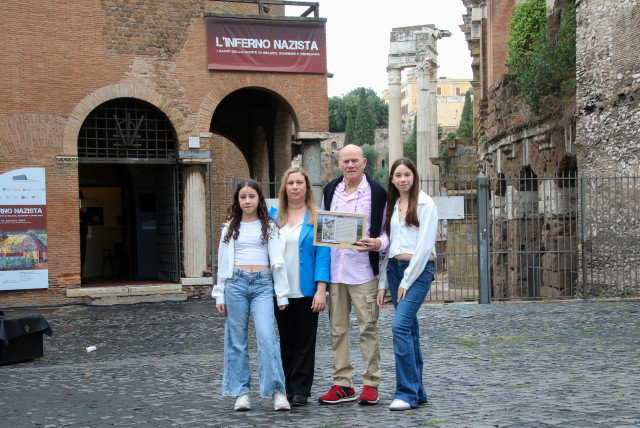March of the Living held in Rome in the shadow of massacre of southern Israelis
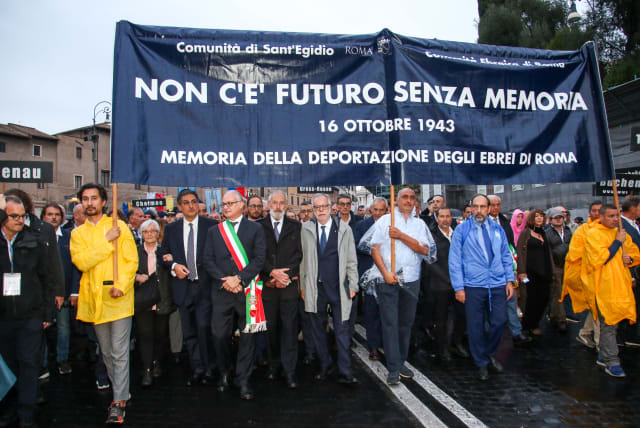
‘“Never Again” has happened again’.
Against the horrifying backdrop of the massacre of Jews in Israel’s South, Revital Yakin Krakovsky, deputy CEO of the International March of the Living, and Michel Gourary, director of the European March of the Living, were in Rome this week for the observance of Italy’s Holocaust Remembrance Day and Italy’s \ of the Living on October 16, marking 80 years since the deportation of Italian Jewry to Auschwitz.
The march was held on Monday evening in the presence of the President of the Republic of Italy, Sergio Mattarella; the Mayor of Rome, Roberto Gualtieri; Holocaust survivors; and members of the Jewish and Christian community
October 16, 1943, marked the first deportation of the Jews in Rome. One thousand Jews were sent to the Auschwitz extermination camp on that day, where they were murdered. The march, held on October 16, 2023, began at the Capitol and concluded at the Great Synagogue located in the Jewish ghetto in Rome, where the closing ceremony was held. Due to the ongoing war in Israel, the march was conducted under heavy security.
The fact that the march commemorating the deportation of Italian Jewry to Auschwitz took place just days after the massacre of over 1,000 Jews in Israel’s South was not lost on those in attendance.
Gourary said, “Eighty years ago, the Nazis brutally dragged 1,250 Roman Jews from their homes at 7 a.m. and put them on a train to Auschwitz. Just 10 days ago, the new Nazis of Hamas entered houses and military bases in Israel’s South and butchered 1,400 Israelis. For the last 80 years, we repeated our commitment: ‘Never Again,’ but it happened again.”
The March of the Living in Rome took place against the backdrop of the war in Gaza. Krakovsky said, “We marched here today in Rome to remind the world that the Holocaust must be remembered as the most terrible chapter in human history. Unfortunately, the lessons are very relevant today: murderous hatred of Jews has not vanished. Last week, Israel paid an unimaginable price in blood, in the greatest murder of Jews since the Holocaust.
“We marched in Rome today at the place from where the city’s Jews were sent to Auschwitz, with a heavy heart and great pain for the Jews of Italy murdered 80 years ago, and for the people of Israel e murdered last week in the vicious terror attack.”
Victor Fadlun, president of the Jewish community of Rome, said that since the Hamas attack on Israel, the community has become very active in explaining the emotions surrounding the highly charged situation to the media, as well as raising funds for Israel.
“We thought that no one would ever again dare to enter our homes, kill our children, divide families, and take away children, women, and the elderly just because we are Jews. But it happened again. In Israel, in the Jewish state. We are the Jews of Rome, and we stand proudly alongside the State of Israel where our sisters and brothers live, the only democracy in the Middle East,” he said.
JOANNA ARBIB, a member of the Board of the Roman Jewish Community responsible for international relations, said that canceling the march was not an option. “The organizers are very aware of safety concerns, but there has been no thought of canceling the march. As our sages teach, we have to continue to live as proud Jews and must not be afraid.”
Jews have lived in Italy for over 2,000 years, and the Italian Jewish community numbered some 50,000 people during the 1930s.
Benito Mussolini, head of the Fascist party, became prime minister of Italy in March 1922. While some party leaders were antisemitic, the party was not an overtly antisemitic organization. In fact, until 1938 Jews were permitted to join the Fascist Party.
In 1938, under pressure from their German allies, the Italian government passed antisemitic legislation, which, among other things, prohibited Jews from holding government jobs, removed them from positions in the mass media, and banned marriage between Jews and non-Jews. In September 1943, Italy surrendered to the Allies. The Germans then occupied northern and central Italy and established an SS and police organization to deport the Jews to Auschwitz-Birkenau.
In October and November 1943, the Germans rounded up Jews in Rome, Milan, Genoa, Florence, Trieste, and other major cities in northern Italy.
Some 7,680 Italian Jews were killed in the Holocaust from a community of 44,500 individuals. Deportations from Italy began in October 1943, starting from Rome, followed by further deportations from other cities across the country. Many Italian Jews were arrested and detained in camps within the country, and some were sent into forced labor. The Germans received full cooperation from the Italians.
Krakovsky’s participation in the Italian March of the Living was much more than an official visit on behalf of the International March of the Living. It was the closing of a circle dating back to her great-grandfather, Angelo Sonnino.Sonnino was born in 1893 in Rome and earned his living selling souvenirs. In 1943, the Germans captured him at his souvenir stand in Piazza Venezia, the central hub of Rome, and sent him to Auschwitz, where he was murdered in 1943.
Angelo and his wife, Silvia, had six children. One of their daughters, Silvana, worked at a restaurant in the Termini train station, where she met the man she would marry – David Yakin, who had gone to Rome from Israel as a member of the Jewish Brigade to fight the Nazis.
Before the Nazis captured Angelo, he had met David and gave him his blessing to marry his daughter Silvana and move to Israel after the war to help establish a Jewish state. In January 1945, after the war had ended, David Yakin and Silvana married. Shortly thereafter, they made aliyah. David Yakin fought in Israel’s War of Independence. The couple had four sons, including Yair Yakin, Revital’s father.
KRAKOVSKY, WHO traveled to Italy with her father and two daughters, says that participating in the march, which commemorates the events that led to the death of her great-grandfather, was a special moment. “It was exciting to participate with three generations of life in a place where the Nazis intended to end the life of my family and the Jewish people. The march ends in the synagogue in Rome, which is the very place where my grandparents married.”She explains that the Germans took her great-grandfather on January 6, 1943, the same date she was born some 35 years later. “There is symbolism in the date,” she says. “I have participated in over 20 Marches of the Living, and my great-grandfather is with me in spirit whenever I go.”
Krakovsky says that her grandmother told her many stories about her Holocaust experiences. Once, her grandmother related, the Germans had caught her and her mother and were filling a transport with Jews to take to Auschwitz. There were no more spaces left on the transport, and miraculously, she and her mother were saved.
“My grandmother’s stories were like suspense tales for me when I was a child growing up,” says Krakovsky, who retold her grandmother’s stories to her children when she herself became a mother. “I believe that the story of the Holocaust is like the story of the Exodus from Egypt as expressed in the Passover Haggadah. ‘You shall tell it to your children.’” Krakovsky relates that her grandmother spent more time telling these stories to her grandchildren and great-grandchildren than her own children, who were busy building the country.
“It was clear to me that my daughters would take the stories with them, and I returned to Rome with the girls, where my younger daughter celebrated her bat mitzvah,” says Krakovsky. “I am certain that my grandmother is looking down from above and is deriving great pleasure.”
Krakovsky adds that for her daughters, participating in the March of the Living in Italy is not only a matter of retelling the story of the Holocaust but also one of doing, and marching on foot. “We don’t remember the Holocaust only through studying the subject in school or listening to our grandparents’ stories. We remember by seeing where the people lived, where they died, and where they survived.”
Krakovsky says that for her, the Holocaust that occurred in Italy teaches the importance of remembrance. “Our educational mission will grow and increase,” she explains, “because we see the denial of the Holocaust, even while the survivors are still alive. We know that in another 10 or 15 years, there will be no more witnesses who were there, and the power of deniers will increase. We need to establish defenders of the truth – people who will visit the sites and defend the truth.”
She adds that another important lesson is that commemorating the Holocaust is not only for the Jewish people. “Fully half of the participants in the March of the Living are not Jewish. The lessons of the Holocaust are universal. The world must remember what happened to the Jewish people so that it will not happen to any other nation or minority.”
“The way to fight antisemitism today is through Holocaust education,” she notes. “If we don’t educate about the Holocaust, we cannot struggle effectively on antisemitism and racism and tolerance for other people. The Holocaust shows us where hate can lead. It is a warning sign for the entire world.
“Our task at the March of the Living is to continue to wave the red light of how this danger can lead to genocide and antisemitism.”
This article was written in cooperation with the International March of the Living
Jerusalem Post Store
`; document.getElementById("linkPremium").innerHTML = cont; var divWithLink = document.getElementById("premium-link"); if (divWithLink !== null && divWithLink !== 'undefined') { divWithLink.style.border = "solid 1px #cb0f3e"; divWithLink.style.textAlign = "center"; divWithLink.style.marginBottom = "15px"; divWithLink.style.marginTop = "15px"; divWithLink.style.width = "100%"; divWithLink.style.backgroundColor = "#122952"; divWithLink.style.color = "#ffffff"; divWithLink.style.lineHeight = "1.5"; } } (function (v, i) { });

